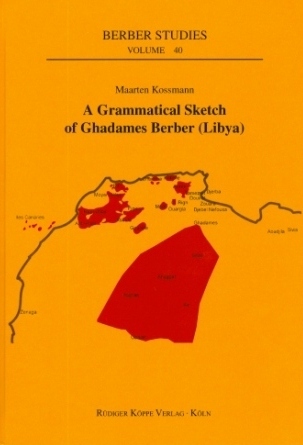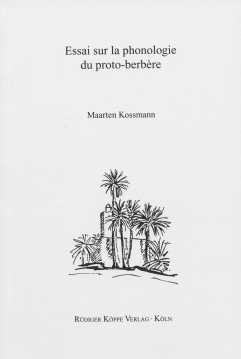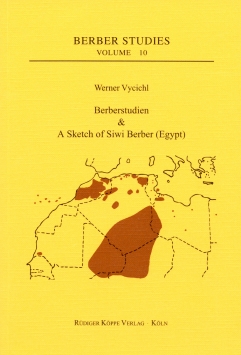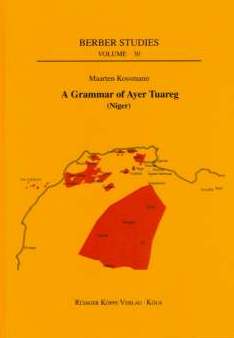



A Grammatical Sketch of Ghadames Berber (Libya)
Author: Maarten Kossmann. Series edited by: Harry Stroomer.
Series: BS Berber Studies Volume 40
201312 pp. Roman, 200 pp.
numerous tables and charts
Text language(s): English
Format: 170 x 240 mm
540 g
Hardcover
€ 49.80
Buy 'A Grammatical Sketch of Ghadames Berber (Libya)' as a downloadable PDF document directly from our online shop »
Order 'A Grammatical Sketch of Ghadames Berber (Libya)' as print edition »
The oasis of Ghadames lies on the Libyan side of the place where Algeria, Tunisia and Libya meet. Its present population ranges to about 10,000 people, not all of whom are natives of the oasis. Traditionally, its inhabitants live from date palm cultivation and long-distance trade, especially to sub-Saharan Africa. Nowadays, the old town of Ghadames, albeit a Unesco World Heritage site since 1986, is being abandoned by its inhabitants, who move to modern housing nearby.
The traditional language of the oasis is Berber and has been studied by two scholars. The first one was Adolphe de Calassanti Motylinski, who published his Le dialecte berbere de R’edames in 1904. The second scholar who worked seriously on Ghadames was the White Father Jacques Lanfry. During his stay from 1944 to 1945 he collected an important amount of materials, which he started to publish in the late 1960s. Since Lanfry left Ghadames, no linguists have worked on the spot any more, and all studies concerning Ghadames Berber are based on previous works.
Ghadames constitutes a Berber language on its own, which has followed different historical paths from all other languages. It preserves a number of phonological features that are not commonly found elsewhere and in its morphology, Ghadames also has a number of highly unusual features. While much of its syntax follows general Berber patterns, a number of outstanding features occur. Ghadames Berber lexicon has undergone relatively low influence from Arabic. Thus, in a count of loanwords in traditional narrative texts, Ghadames has 18% loanwords from Arabic, whereas languages such as Tashelhiyt and Figuig have twice as much. Furthermore, there are a number of recognizable loans from Tuareg and Hausa.
In spite of the importance of Lanfry’s materials, in Berber studies the language of Ghadames has not yet been given the place it deserves. This may be due to the fact that Lanfry’s studies are difficult to obtain, and that Lanfry’s notations prove somewhat difficult to interpret for a superficial reader. Moreover, while Lanfry provides a detailed description of verbal morphology, other subjects remain underrepresented, such as syntax. This is the reason for the author’s decision to write this short grammatical sketch, based on Lanfry’s materials.
Under these links you will find monographs and many contributions to paper collections by the author, as well as further descriptions of Libyan Berber languages and reviews of this grammar:
Accompanying material:
- A Grammar of Awjila Berber (Libya)
(ISBN 978-3-89645-941-1 ) - Ferhat
(ISBN 978-3-89645-396-9 ) - Origin and Development of the Libyco-Berber Script
(ISBN 978-3-89645-394-5 ) - Zuaran Berber (Libya)
(ISBN 978-3-89645-926-8 )
Cross-reference:
- « Parcours berbères »
(ISBN 978-3-89645-933-6 ) - A Grammar of Ayer Tuareg (Niger)
(ISBN 978-3-89645-930-5 ) - Aspects of Co- and Subordination
(ISBN 978-3-89645-888-9 ) - Berber in Contact / Le berbère en contact
(ISBN 978-3-89645-922-0 ) - Berber Loanwords in Hausa
(ISBN 978-3-89645-391-4 ) - Berberstudien & A Sketch of Siwi Berber (Egypt)
(ISBN 978-3-89645-389-1 ) - Essai sur la phonologie du proto-berbère
(ISBN 978-3-89645-035-7 ) - Études berbères (I)
(ISBN 978-3-89645-015-9 ) - Études berbères III – Le nom, le pronom et autres articles
(ISBN 978-3-89645-393-8 ) - Études berbères V – Essais sur des variations dialectales et autres articles
(ISBN 978-3-89645-928-2 )
Reviews
Mit vorliegender Monographie legt Maarten Kossmann, einer der bedeutendsten Berberologen der Gegenwart, eine systematische und übersichtliche Reanalyse der Grammatik dieser Sprache vor. Kossmann hat keine eigene Feldforschung unternommen, sondern wertet die älteren Materialien vor allem von Lanfrys und die von diesem publizierten Texte gründlich aus. Durch diese Neuaufbereitung soll der Zugang zu der Sprache erleichtert werden, die sich deutlich von den anderen Berbersprachen unterscheidet und daher ein besonderes Interesse verdient. [...]
Ich möchte [...] noch kurz auf die Bedeutung der Sprache von Ghadames für die Berberologie zu sprechen kommen. Kossmann sagt: „Ghadames constitutes a Berber language on its own, which has followed historical paths different from all other languages“ (S. 3). Ich möchte diese Ahnung hier zu der Hypothese verschärfen, dass das Ghadames (evtl. zusammen mit dem Awjila) im genetischen Stammbaummodell die erste Abzweigung vom Proto-Berberischen darstellt und somit (fast) allen übrigen Berbersprachen gegenübersteht. Hier sei nur ein Argument aus dem Lexikon genannt, nämlich das Wort für „Ohr“, in Ghadames „ésem“. Dieses hat eine Parallele allein in der ebenfalls in Libyen gesprochenen, nahezu extinkten Sprache von Awjila (ísem), während alle übrigen Berbersprachen eine andere Wurzel verwenden [...]. Dagegen hat „ésem“ Parallelen im Tschadischen [...].
Natürlich kommt einem einzigen Lexem nur eine begrenzte Aussagekraft zu, aber wenn wir die berberisch-tschadische Gleichung akzeptieren und Entlehnung bei diesem elementaren Wort für unwahrscheinlich halten, so folgt doch, dass eine Innovation aller Berbersprachen mit Ausnahme von Ghadames und Awjila vorliegt und somit all jene im genetischen Modell einen eigenen Zweig konstitutieren. Wenn dies stimmt, ist die Bedeutung der Sprache von Ghadames für die Rekonstruktion des Proto-Berberischen nicht allein wegen ihres lautlichen und morphologischen Archaismus, sondern auch wegen ihrer Stellung im Stammbaum erheblich, hätte sie dann doch so viel Gewicht wie alle anderen Berbersprachen zusammen. So sind wir M. Kossmann dankbar, dass er diese Sprache in einer klaren und übersichtlichen Darstellung zugänglich gemacht hat. Es bleibt zu hoffen, dass die verbleibenden Lücken sich durch künftige Feldforschung noch werden schließen lassen.
Carsten Peust in Orientalistische Literaturzeitung, 110/4-5, 2015, 405-408
This is a welcome reorganization and reanalysis of Ghadames Berber (GhB) materials left chiefly by Jacques Lanfry, a missionary linguist, who collected data prior to 1945. Kossmann expertly distills the primary material into a convenient one-stop descriptive source. [...]
GhB has a special place in comparative Berber, and we owe Kossmann a round of applause for making the data accessible and for defining the controversial historical issues that they bear on.
Jeffrey Heath in Journal of African Languages and Linguistics, 37/1, 2016, 161-163
PDF documents:
 | Table of Contents | (≈ 170 kB) |
 | Review by Jeffrey Heath | (≈ 75 kB) |
| « back | Print version | [top] |
 Books
Books Audio
Audio Biographies
Biographies Series
Series Festschrifts
Festschrifts Journals
Journals